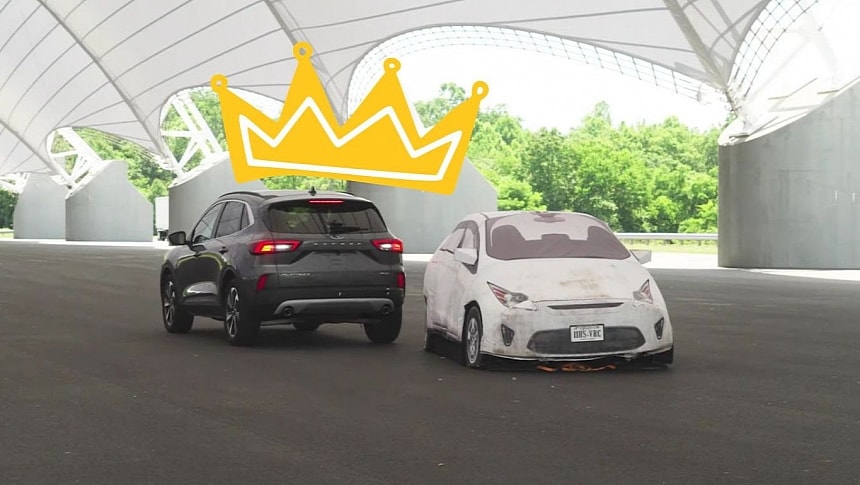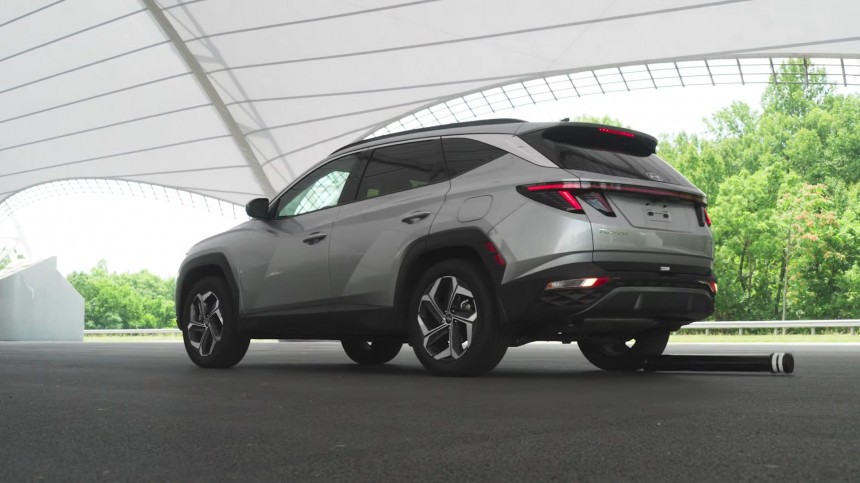The Insurance Institute for Highway Safety has released a new round of rear crash prevention ratings on eight of the nation's most popular small sport utility vehicles. By rear crash prevention, the nonprofit organization refers to an automobile's ability to avoid crashes while backing up by identifying an obstacle via ultrasonic sensors and automatically applying the brakes to avoid or mitigate a collision.
As you might have guessed by now, the IIHS determined that not all AEB systems are created equal. Of the eight utility vehicles in this group, the 2023 – 2024 Hyundai Tucson scored basic. It failed to avoid or slow a collision in every single test scenario, though it did provide a warning as it neared the obstacle in certain instances.
Advanced is the middle-of-the-road accolade, which applies to the Mazda CX-5, Toyota RAV4, and Volkswagen Taos from the same model years as the aforementioned 2023 – 2024 Hyundai Tucson. All three hit the dummy car target when angled at 10 degrees, although the rear AEB performance did improve at 45 angles.
Be that as it may, the aging CX-5 and the Mexico-built Taos had trouble avoiding an offset bollard. As for the hugely popular RAV4, the IIHS found out that its rear automatic emergency braking system avoided collisions in two trials while braking substantially in the third test.
David Aylor, vice president of active safety at IIHS, says that the rear AEB evaluation is designed around the most common backing crashes in the United States of America. No fewer than four small crossovers excelled in this evaluation, beginning with the Escape.
Ford's compact-sized crossover avoided collisions in a consistent fashion, hitting the target dummy car target in one trail when said target was positioned at a 10-degree angle to the Escape's backward path. The Subaru Forester couldn't avoid the target at 45 degrees, while the Honda CR-V and Mitsubishi Outlander made contact in both the 45- and 10-degree tests. The CR-V came out worse, for it also hit a bollard once.
The IIHS-affiliated Highway Loss Data Institute says that almost 30 percent of collision claims from 2022 were for rear points of impact costing in excess of 4,000 buckaroos. The rear automatic emergency braking system, meanwhile, is estimated to cost as little as 600 bucks.
HLDI evaluations reveal that rear AEB shales the frequency of claims for damage to other vehicles by 29 percent. Over at the IIHS, a study from 2018 indicated that rear AEB combined with rear cameras and parking sensors reduced the incidence of police-reported backing crashes by 78 percent. Although these safety features add to the final price of a new vehicle, there's no denying that effective safety features will also save you money in the long run.
Speaking of money, the best-performing SUV of the eight-strong batch starts at $27,995 excluding destination charge. It's twinned with the Mexico-built Bronco Sport, which carries a starting price of $29,795 for the 2024 model year.
Advanced is the middle-of-the-road accolade, which applies to the Mazda CX-5, Toyota RAV4, and Volkswagen Taos from the same model years as the aforementioned 2023 – 2024 Hyundai Tucson. All three hit the dummy car target when angled at 10 degrees, although the rear AEB performance did improve at 45 angles.
Be that as it may, the aging CX-5 and the Mexico-built Taos had trouble avoiding an offset bollard. As for the hugely popular RAV4, the IIHS found out that its rear automatic emergency braking system avoided collisions in two trials while braking substantially in the third test.
David Aylor, vice president of active safety at IIHS, says that the rear AEB evaluation is designed around the most common backing crashes in the United States of America. No fewer than four small crossovers excelled in this evaluation, beginning with the Escape.
The IIHS-affiliated Highway Loss Data Institute says that almost 30 percent of collision claims from 2022 were for rear points of impact costing in excess of 4,000 buckaroos. The rear automatic emergency braking system, meanwhile, is estimated to cost as little as 600 bucks.
HLDI evaluations reveal that rear AEB shales the frequency of claims for damage to other vehicles by 29 percent. Over at the IIHS, a study from 2018 indicated that rear AEB combined with rear cameras and parking sensors reduced the incidence of police-reported backing crashes by 78 percent. Although these safety features add to the final price of a new vehicle, there's no denying that effective safety features will also save you money in the long run.
Speaking of money, the best-performing SUV of the eight-strong batch starts at $27,995 excluding destination charge. It's twinned with the Mexico-built Bronco Sport, which carries a starting price of $29,795 for the 2024 model year.

















